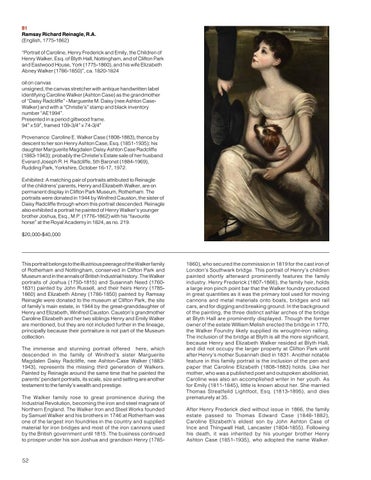81 Ramsay Richard Reinagle, R.A. (English, 1775‑1862) “Portrait of Caroline, Henry Frederick and Emily, the Children of Henry Walker, Esq. of Blyth Hall, Nottingham, and of Clifton Park and Eastwood House, York (1775‑1860), and his wife Elizabeth Abney Walker (1786‑1850)”, ca. 1820‑1824 oil on canvas unsigned, the canvas stretcher with antique handwritten label identifying Caroline Walker (Ashton Case) as the grandmother of “Daisy Radcliffe” - Marguerite M. Daisy (nee Ashton CaseWalker) and with a “Christie’s” stamp and black inventory number “AE1994”. Presented in a period giltwood frame. 94” x 59”, framed 109‑3/4” x 74‑3/4” Provenance: Caroline E. Walker Case (1808‑1883), thence by descent to her son Henry Ashton Case, Esq. (1851‑1935); his daughter Marguerite Magdalen Daisy Ashton Case Radcliffe (1883‑1943); probably the Christie's Estate sale of her husband Everard Joseph R. H. Radcliffe, 5th Baronet (1884‑1969), Rudding Park, Yorkshire, October 16‑17, 1972. Exhibited: A matching pair of portraits attributed to Reinagle of the childrens’ parents, Henry and Elizabeth Walker, are on permanent display in Clifton Park Museum, Rotherham. The portraits were donated in 1944 by Winifred Causton, the sister of Daisy Radcliffe through whom this portrait descended. Reinagle also exhibited a portrait he painted of Henry Walker’s younger brother Joshua, Esq., M.P. (1776‑1862) with his “favourite horse” at the Royal Academy in 1824, as no. 219. $20,000‑$40,000
This portrait belongs to the illustrious peerage of the Walker family of Rotherham and Nottingham, conserved in Clifton Park and Museum and in the annals of British Industrial history. The Walker portraits of Joshua (1750-1815) and Susannah Need (17601831) painted by John Russell, and their heirs Henry (17851860) and Elizabeth Abney (1786-1850) painted by Ramsay Reinagle were donated to the museum at Clifton Park, the site of family’s main estate, in 1944 by the great-granddaughter of Henry and Elizabeth, Winifred Causton. Causton’s grandmother Caroline Elizabeth and her two siblings Henry and Emily Walker are mentioned, but they are not included further in the lineage, principally because their portraiture is not part of the Museum collection. The immense and stunning portrait offered here, which descended in the family of Winifred’s sister Marguerite Magdalen Daisy Radcliffe, nee Ashton-Case Walker (18831943), represents the missing third generation of Walkers. Painted by Reinagle around the same time that he painted the parents’ pendant portraits, its scale, size and setting are another testament to the family’s wealth and prestige. The Walker family rose to great prominence during the Industrial Revolution, becoming the iron and steel magnate of Northern England. The Walker Iron and Steel Works founded by Samuel Walker and his brothers in 1746 at Rotherham was one of the largest iron foundries in the country and supplied material for iron bridges and most of the iron cannons used by the British government until 1815. The business continued to prosper under his son Joshua and grandson Henry (1785-
52
1860), who secured the commission in 1819 for the cast iron of London’s Southwark bridge. This portrait of Henry’s children painted shortly afterward prominently features the family industry. Henry Frederick (1807-1866), the family heir, holds a large iron pinch point bar that the Walker foundry produced in great quantities as it was the primary tool used for moving cannons and metal materials onto boats, bridges and rail cars, and for digging and breaking ground. In the background of the painting, the three distinct ashlar arches of the bridge at Blyth Hall are prominently displayed. Though the former owner of the estate William Melish erected the bridge in 1770, the Walker Foundry likely supplied its wrought-iron railing. The inclusion of the bridge at Blyth is all the more significant, because Henry and Elizabeth Walker resided at Blyth Hall, and did not occupy the larger property at Clifton Park until after Henry’s mother Susannah died in 1831. Another notable feature in this family portrait is the inclusion of the pen and paper that Caroline Elizabeth (1808-1883) holds. Like her mother, who was a published poet and outspoken abolitionist, Caroline was also an accomplished writer in her youth. As for Emily (1811-1845), little is known about her. She married Thomas Streatfeild Lightfoot, Esq. (1813-1895), and dies prematurely at 35. After Henry Frederick died without issue in 1866, the family estate passed to Thomas Edward Case (1848-1882), Caroline Elizabeth’s eldest son by John Ashton Case of Ince and Thingwall Hall, Lancaster (1804-1855). Following his death, it was inherited by his younger brother Henry Ashton Case (1851-1935), who adopted the name Walker.
